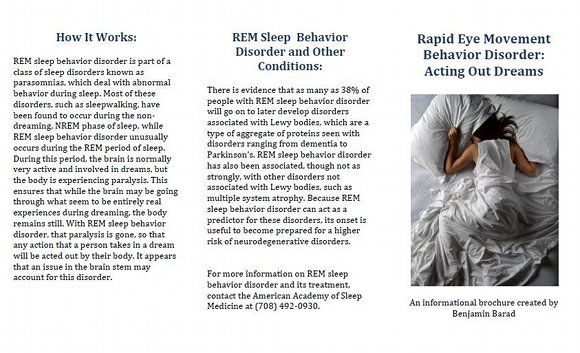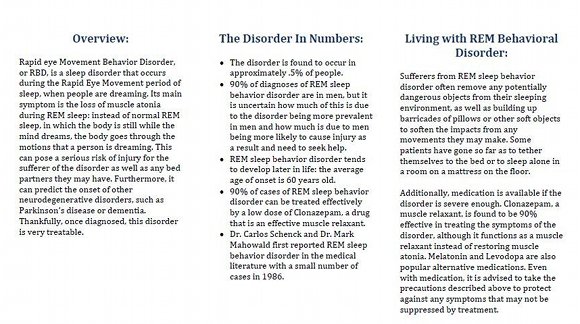
| Connect & Subscribe |
REM Behavioral Disorder Brochure
An Outreach Project by Benjamin Barad | Return To Outreach Projects 2010
The following is a brochure created for Stanford Sleep and Dreams. If it is difficult to read using the images, you may view the full text here.
Also feel free to download this brochure for distributional or general information purposes. Please refer to our privacy policy for our relevant disclaimers.


Overview:
Rapid eye Movement Behavior Disorder, or RBD, is a sleep disorder that occurs during the Rapid Eye Movement period of sleep, when people are dreaming. Its main symptom is the loss of muscle atonia during REM sleep: instead of normal REM sleep, in which the body is still while the mind dreams, the body goes through the motions that a person is dreaming. This can pose a serious risk of injury for the sufferer of the disorder as well as any bed partners they may have. Furthermore, it can predict the onset of other neurodegenerative disorders, such as Parkinson's disease or dementia. Thankfully, once diagnosed, this disorder is very treatable.
REM Behavior Disorder In Numbers:
Living with REM Behavior Disorder:
Sufferers from REM sleep behavior disorder often remove any potentially dangerous objects from their sleeping environment, as well as building up barricades of pillows or other soft objects to soften the impacts from any movements they may make. Some patients have gone so far as to tether themselves to the bed or to sleep alone in a room on a mattress on the floor.
Additionally, medication is available if the disorder is severe enough. Clonazepam, a muscle relaxant, is found to be 90% effective in treating the symptoms of the disorder, although it functions as a muscle relaxant instead of restoring muscle atonia. Melatonin and Levodopa are also popular alternative medications. Even with medication, it is advised to take the precautions described above to protect against any symptoms that may not be suppressed by treatment.
How It Works:
REM sleep behavior disorder is part of a class of sleep disorders known as parasomnias, which deal with abnormal behavior during sleep. Most of these disorders, such as sleepwalking, have been found to occur during the non-dreaming, NREM phase of sleep, while REM sleep behavior disorder unusually occurs during the REM period of sleep. During this period, the brain is normally very active and involved in dreams, but the body is experiencing paralysis. This ensures that while the brain may be going through what seem to be entirely real experiences during dreaming, the body remains still. With REM sleep behavior disorder, that paralysis is gone, so that any action that a person takes in a dream will be acted out by their body. It appears that an issue in the brain stem may account for this disorder.
REM Sleep Behavior Disorder and Other Conditions:
There is evidence that as many as 38% of people with REM sleep behavior disorder will go on to later develop disorders associated with Lewy bodies, which are a type of aggregate of proteins seen with disorders ranging from dementia to Parkinson's. REM sleep behavior disorder has also been associated, though not as strongly, with other disorders not associated with Lewy bodies, such as multiple system atrophy. Because REM sleep behavior disorder can act as a predictor for these disorders, its onset is useful to become prepared for a higher risk of neurodegenerative disorders.
For more information on REM sleep behavior disorder and its treatment, contact the American Academy of Sleep Medicine at (708) 492-0930.
An informational brochure created by Benjamin Barad
About This Site
Welcome! This site is continuously being created by students of Dr. William C. Dement's Sleep And Dreams course at Stanford University.
We made this site as a call to action for people all over the world to live healthier, happier, safer, and more productive lives by learning about their own sleep. We have faith that reading the information provided on this site will motivate you to be smart about your sleep deprivation and strategic about your alertness in order to live life to your fullest, most energetic potential.
In fact, we challenge you to do so! What do you say, are you up for the challenge?
Interviews With Sleep Specialists: Insights Into the Worlds of Sleep Medicine & Sleep Business
America's Most Dangerous Disorder: What Is Sleep Apnea Doing To Your Sleep?
Sleep Debt: How Much More Will You Achieve When You Reduce Yours?
The Stages Of Sleep: The Journey Through The Night
Delayed Sleep Phase: You Want To Sleep But You're Not Tired Yet
Paralyzed at Night: Is Sleep Paralysis Normal?
Sleep In Words: Smart, Strange, and Funny Quotes About Sleep
Sleep Disorders In Children: What's Keeping Your Child From A Full Night's Rest?
Attacks of Pavor Nocturnus (a.k.a. Sleep Terrors, Night Terrors, or Incubus Attacks)
The Stanford Sleep Book
Dr. Dement's pioneering textbook has been the core text for Sleep and Dreams since 1980, but it has just recently been made available to the wider public for the first time.
In it you'll find a more detailed account of the most important things you need to know about sleep, alertness, dreams, and sleep disorders. Studies, statistics, plus plenty of Dr. Dement's classic anecdotes painting the history of sleep medicine.
Preface | Intro | Contents | Get A Copy
More Sleep Resources
The Zeo
A revolution in personal sleep tracking, the Zeo is a wireless headband that transmits your brainwaves in realtime to a dock (pictured here) or your smartphone. The result? You can wake up and see exactly what stages of sleep you were in during the night! Unprecedented personalized sleep knowledge.
Sleep Paralysis: A Dreamer's Guide
Ever woken up paralyzed? A surprising number of us have, believe it or not. But few know the actual causes of this phenomenon, and fewer still how to exert control over it. Dream researcher and sleep paralysis expert Ryan Hurd shares breakthrough insights into how to do just that.
Important Disclaimer
Please Note:
The information found on this page and throughout this site is intended for general information purposes only. While it may prove useful and empowering, it is NOT intended as a substitute for the expertise and judgments of healthcare practitioners.
For more info, see our
Terms of Use.









